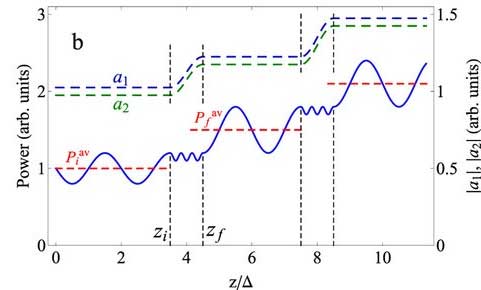| Posted: Nov 22, 2016 |
Signal transmission in a photonic computer without losses
(Nanowerk News) Scientists from the Institute for Theoretical and Applied Electromagnetics of the RAS, the All-Russia Research Institute of Automatics and MIPT have calculated a model of an optical system in which large losses in waveguides are compensated by a small gain. The newly discovered phenomenon means that a signal can be transmitted with virtually no losses, which up until now had been an unresolved issue with plasmonic and nanooptic devices. And it is these devices that will lead to revolutionary changes in computer technology in the near future.
|
|
The study was published in Scientific Reports ("Parametric instability of optical non-Hermitian systems near the exceptional point").
|
|
Photonics is an important area of development in modern science. As in electronics, where signals are transmitted using electrons, in photonics, scientists study signals that are transmitted via photons. This significantly speeds up the process of information transfer, because photons travel at the speed of light.
|
|
Scientists all over the world are trying to build a computer based on optoelectronic elements (energy-efficient light sources, ultrasensitive sensors and detectors, and also high-performance optoelectronic processors).
|
 |
| Fig. 1: Diagram of the system of two coupled waveguides with periodically changing parameters (distance between them)
|
|
An optical waveguide is a channel in which an electromagnetic wave (light) can only propagate in a certain direction. Fiber optic cables are optical waveguides and are already used widely, e.g. for internet connections, including transcontinental lines. However, in waveguides, at microelectronic level – in the “wires” of the chips for an optoelectronic computer, in plasmonic and nanooptic devices – there is a problem of energy loss, and consequently a loss of signal, which is a major limiting factor in terms of their application.
|
|
The scientists decided to examine parametric perturbation in a system of two coupled waveguides. Parametric perturbation is an effect on a system whereby its parameters are altered, which in turn affects the signal passing through. For example, in order to move on a swing, we raise and lower our legs, periodically changing the parameters of the system – the distance from the point of suspension to our center of mass – which increases the maximum angle at which we deviate from the position of equilibrium. By changing the parameters, we can find the perturbation that will have the desired effect on the signal.
|
|
The researchers took one waveguide with an absorbing medium, and another with an amplifying medium. The intensity of the electromagnetic wave in this system changes periodically, either increasing, or decreasing. This is because the electromagnetic wave propagating along one of the waveguides interacts with the other waveguide (the field of the first waveguide is different from zero at the location of the second waveguide and vice versa), which causes the field to flow from one waveguide to the other. Depending on which of the waveguides (absorbing/amplifying) the field maximum is in, the intensity of the wave either decreases, or increases. The speed at which the field flows between the waveguides depends on the distance between the waveguides, the shorter the distance, the greater the speed.
|
|
The authors investigated whether it would be possible, by periodically changing the distance between the waveguides, to “configure” the flow of the field between them so that the amplitude of the electromagnetic field in both waveguides will increase, even if the losses in the first waveguide exceed the gain in the second waveguide.
|
|
The idea was, at the moment when the intensity of the system reaches a maximum, to change the distance between the waveguides in order to concentrate the field in the waveguide with the amplifying medium, which would further increase the intensity of the signal. (On Fig. 2.) By periodically changing the distance between the waveguides, it is theoretically possible to infinitely increase the power (Fig. 1 and Fig. 2.)
|
 |
| Fig. 2: Dependency of signal intensity (solid line) and field amplitude (dashed line) in the first and second waveguides depending on the coordinates along the waveguide.
|
|
The calculations showed that if the parameters of the waveguides are adjusted to an exceptional point at which the wave modes propagating in the waveguide coincide, then virtually any change in the parameters of the system will cause the desired redistribution of the field.
|
|
“By periodically changing the distance between the waveguides, it is indeed possible to ‘configure’ the flow of energy between them so that the electromagnetic fields will be amplified as they propagate along the waveguides, even in cases where the losses exceed the gain”, commented the head of the study Prof. Alexander Pukhov Dr.Sc., a senior researcher at MIPT’s Laboratory of Quantum Information Theory.
|
|
In addition to losses in the waveguides with a gain in signal amplitude, there are also nonlinear effects that inhibit and limit the growth of the amplitudes. This means that by using the model described it will be possible to create a stable signal that will reliably transmit information in photonic circuits and in the future may be used to develop photonic computers.
|


